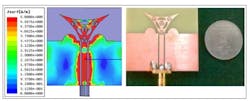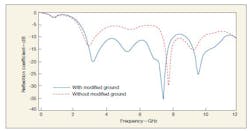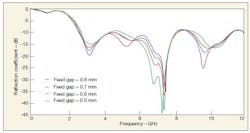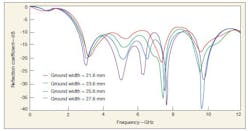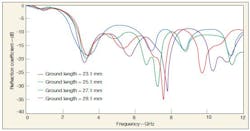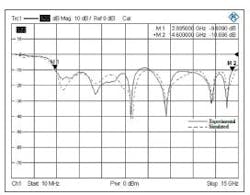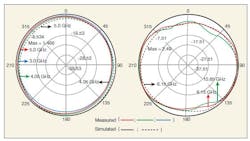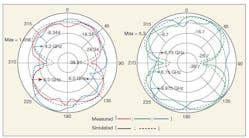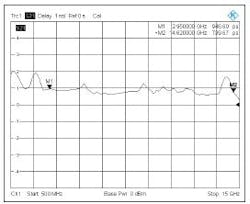Broadband antennas are needed for emerging applications using the ultrawideband (UWB) frequency range from approximately 3.1 to 10.6 GHz. To serve such applications in wireless communications and medical-imaging systems, a fractal antenna using an Appollian-shaped gasket with coplanar-waveguide (CPW) feed was developed. The design offers tremendous potential for various UWB applications, with an experimental impedance bandwidth of 133.905% from 2.89 to 14.60 GHz. The antenna features an omnidirectional H-plane radiation pattern and a bidirectional E-plane radiation pattern.
Since the US Federal Communications Commission (FCC) opened the use of frequencies from 3.1 to 10.6 GHz for UWB communications in 2002, a great deal of attention has been focused on the components needed for such systems.1 Among them, the antenna must be extremely compact, with reasonable gain, an omnidirectional radiation pattern, and constant group delay for minimal distortion of transmission signal. Many different antenna design methodologies have been presented for UWB use, including nonplanar and planar antennas. Nonplanar antennas can achieve the wide bandwidth, but by using large ground planes that increase the overall size of the antenna.2 Printed planar circuits can be made small, and are useful for a variety of applications. Various monopole planar antennas have been designed with partial ground-plane feeds3 and CPW feeds.4
Most planar antennas employ circular or elliptical-shaped geometries capable of broad bandwidths, compared to designs based on rectangular or triangular geometries. Liu, et al.5 reported Apollonian packing monopole antennas with broad, multiband characteristics. Puente6 also reported a monopole fractal antenna with a triangular geometry. Both designs5,6 exhibited multiband performance, but with large ground planes not suitable for integration into microwave-integrated-circuit (MIC) or monolithic-microwave-integrated-circuit (MMIC) devices.
It is typically more difficult to achieve an UWB antenna with a triangular shape compared to an antenna with an Appollian-shaped gasket. The latter is formed from a series of fractal shapes that intersect each other to create a foam-like structure. For a triangular-shaped antenna to achieve broad bandwidth, some modification must be made in either the ground plane or the antenna patch structure. In contrast, antennas based on fractal shapes have more commonly been used for broadband applications. Recently, various circular-shaped fractal antennas have been reported for UWB applications.7,8 The present authors reported an UWB fractal antenna with CPW feed based on a circular geometry,8 although an UWB antenna using an Appollian-shaped gasket or basic triangular shape has not yet been reported.
An Appollian-shaped fractal antenna was designed with a CPW feed for UWB applications by modifying the ground plane with improved bandwidth. The antenna was fabricated and experimentally validated, characterized in term of impedance bandwidth, radiation pattern, peak gain, and group delay. It was fabricated on an FR-4 substrate of size 52 x 44 mm (Fig. 2), constructed from a solid Appollian-shaped gasket structure. The gasket was created by forming three circuits of 60 mm diameter and arranging the circles so that all three touch, as shown in Fig. 1(a). A smaller circle with 26 mm diameter is then formed so that it intersects the meeting point of the other three circles. This pattern is called an "initiator" or "zeroth" iteration of the Appollian gasket, as shown in Fig. 1(b) with a CPW feed.
1. A basic Appollian-shaped gasket formed of multiple intersecting rings is shown in (a), with several iterations made to increase the impedance bandwidth in (b), (c), (d), and (e).
2. The optimized dimensions of the fractal antenna are shown in this diagram, which includes details on the launch connector.
The Appollian-shaped fractal antenna was formed from a solid Appollian-shaped gasket in an iterative fashion. In the first iteration, a circle with radius of 4.2 mm was formed in the solid Appollian-shaped gasket. This circle is subtracted from the solid gasket or initiator Fig. 1(c). The Appollian-shaped gasket is then fitted into this small slotted circle. For the second iteration, circles with radius of 1.7 mm are formed—one in the center and three in the corner—and the Appollian-shaped gasket is made to fit into all four circles [Fig. 1(d)]. For the third iteration, circles with radius of 0.9 mm are slotted in the center and three in the corners. In theory, this iterative process can go on indefinitely, or until the circuits are too small to see or manage. For the purposes of this antenna, the design was finalized with the third iteration Fig. 1(e) and the antenna pattern was connected to a CPW feed. The 50-Ω impedance of the CPW feed was obtained by adjusting the gap width between the ground patterns and the conductive line.
Figure 3 shows the current distribution for the antenna, calculated at 5 GHz. It is apparent that the current distribution is more concentrated at the ground plane near the patch, along the x-axis on the ground plane and the edges of the radiating patch. Since the current distribution is greatest along the edges of the Appollian-shaped patch, its dimensions determine the first resonant frequency of the antenna. The current distribution is also strong near the ground plane (along the y-axis) and on the edges of the feed width, making the gap between the feed and ground plane a significant design parameter. The width of the ground plane is also an important design parameter, since the current distribution is strong along the x-axis.
3. The photograph (right) shows the fractal antenna with Appollian-shaped gasket
fabricated on FR-4 substrate of size 52 x 44 mm, with its current distribution at 5 GHz shown on the left.
Simulations on the antenna’s key design parameters were performed with the aid of a commercial electromagnetic (EM) simulation program, the High-Frequency Structure Simulator (HFSS) from Ansoft (www.ansys.com). The antenna was simulated for the gap between the ground plane and the feed line, the ground width, and the ground length. It was first simulated with a simple rectangular ground plane and optimized for the best possible impedance bandwidth. As seen from Fig. 4, it was not possible to achieve a wide impedance bandwidth with a rectangular-shaped ground plane. It was necessary to modify the ground plane to improve the impedance bandwidth, achieved by embedding two semicircles within the ground plane. The radii of the two semicircles on both sides of the ground plane were optimized to r1 = 0.3 mm and r2 = 3.8 mm. Figure 4 also shows the enhanced impedance bandwidth as a result of this modified ground structure.
4. These curves show the simulated reflection coefficient of the fractal antenna, with
and without the modified ground plane.
Simulations on the antenna were performed for various values of the gap between the feed line and the ground plane. The gap was increased from 0.5 to 0.8 mm in 0.1 mm steps with all other design parameters remaining the same. Figure 5 shows the results of the simulations performed with the different gap sizes. As can be seen, as the gap increased from 0.5 to 0.8 mm, the impedance matching improved throughout the band. This is because the real part of the impedance approaches 50 Ω with the increasing gap size, while the imaginary part of impedance approaches zero. In the range of gap sizes simulated, an 0.8 mm gap was found to provide optimum results.
5. These simulations show the effects of varying the size of the gap between the ground plane and the feed.
The antenna was also simulated with respect to different ground-plane widths, from 21.6 to 27.6 mm in 2-mm steps with all other design parameters remaining the same. Figure 6 shows the results of these simulations with different ground-plane widths. As can be seen, at the same time the ground-plane width increases, the first resonant frequency shifts to the lower-frequency side. This is because the current distribution along the x-axis decreases or increases. An optimum value of the ground-plane width will provide an impedance bandwidth suitable for UWB applications; non-optimal values will result in a decrease in the antenna’s impedance bandwidth. This is because the ground-plane width behaves like an inductive resonant circuit element over which the current is distributed along the x-axis of the ground plane. As the ground-plane width increases or decreases, the inductive reactance also increases or decreases. At an optimum value of ground-plane width, the inductive value will be at a minimum, implying that the ground-plane width is an important design parameter for achieving a wide bandwidth.
6. These simulations show the effects of varying the ground-plane width.
Simulations were also performed on the antenna by altering the ground-plane length, from 23.1 to 29.6 mm in 2-mm steps, with all other design parameters remaining the same. Figure 7 shows the results of these simulations. As can be seen, while the ground-plane length increases, the lower-frequency edge of the operating band shifts downward in frequency. No major effects were noticed at the high-frequency edge of the bandwidth, indicating that the ground-plane length does not considerably impact the impedance bandwidth of the antenna.
7. These simulations show the effects of varying the ground-plane length.
Figure 2 shows the fractal antenna with Appollian-shaped gasket and its optimized dimensions, while Fig. 3 provides a photograph of the fabricated antenna, assembled with an SMA connector on the feed line for testing purposes. The antenna was evaluated with a commercial microwave vector network analyzer (VNA), revealing that the usable bandwidth extends from 2.89 to 14.60 GHz, or an impedance bandwidth of 133.91%. These measured results are very close to the simulated values, as shown in Fig. 8. These measurements show that multiple resonances lie at frequencies of 3.71, 5.62, 7.865, and 10.13 GHz. These resonance modes merge with each other, yielding an overall wide bandwidth with VSWR of 2.0:1 or less. The variations that were found between the simulated and measured results may be due to manufacturing tolerances, to uncertainties in the thickness and/or dielectric constant of the circuit-board material, and perhaps to the questionable quality of the SMA connector (itself with a VSWR of 1.30:1). Another factor is the dissipation factor of the substrate, at tan ∆ = 0.020.
8. These traces compare the simulated and measured (experimental) results for the fractal antenna from 10 MHz to 15 GHz.
The antenna’s radiation patterns were measured at selective frequencies. For the H-plane patterns, measurements were performed at 3.0, 4.05, 5.0, 6.15, and 10.65 GHz, as shown in Fig. 9. For the E-plane patterns, measurements were conducted at 4.2, 6.0, 6.75, and 9.975 GHz, as shown in Fig. 10. The measurements show that the antenna is essentially omnidirectional in the H plane and bidirectional in the E plane. The H- and E-plane radiation patterns were also simulated, and the measured results were found to be close to the simulations at the various frequencies of interest. Variations in the radiation patterns were found at the higher frequencies, possibly due to the fractal nature of the antenna structure and the loss tangent of the substrate. As Fig. 11 shows, the peak gain of the antenna increases with increasing frequency, since wavelengths are shorter at higher frequencies relative to the effective receive area of the antenna.
9. These plots show the measured and simulated H-plane radiation patterns.
10. These plots show the measured and simulated E-plane radiation patterns.
11. The measured peak gain of the fractal antenna is plotted here from 2 to 12 GHz.
The antenna’s group delay was also evaluated, since constant group delay across the operating frequency range indicates good phase linearity. Group delay and phase linearity are key parameters of an antenna’s capability of transmitting and receiving signals without distortion. The group delay, τg, is defined as τg= δΦ/2πδf, where Φis the far-field phase and f is the operating frequency.
The group delay was measured with the VNA by fabricating and evaluating two identical antennas, connecting the antennas to the two ports of the analyzer. The VNA was then switched to forward-transmission (S21) measurement mode. The distance between the two antennas was maintained at 50 cm while the group delay was measured. The results of the measurements are shown as a function of frequency in Fig. 12. The measured group delay is almost constant throughout the operating band, indicating good phase linearity.
12. The measured group delay of the fractal antenna is plotted here from 500 MHz to 15 GHz.
In summary, an Appollian-shaped fractal antenna was designed, fabricated, and characterized. It appears to meet the FCC’s requirements for UWB operation, with a bandwidth of 2.89 to 14.60 GHz. It provides nearly omnidirectional H-plane radiation pattern and bidirectional E-plane radiation pattern, with almost constant measured group delay throughout the operating frequency band.
Acknowledgments
The authors are grateful to the Vice Chancellor, Pro-VC, Dean of Defence Institute of Advanced Technology (Deemed University), Pune, India for allowing them to publish this work. Raj Kumar is also grateful to a colleague at the Department of Electronics Engineering at Deemed University for timely support and cooperation.
References
1. G.R. Aiello and G.D. Rogerson, "Ultra-wideband Wireless Systems," IEEE Microwave Magazine, June 2003, pp. 36-47.
2. Narayan Prasad Agrawall, Girish Kumar, and K.P. Ray, "Wide-Band Planar Monopole Antennas," IEEE Transactions on Antennas and Propagation, Vol. 46, No. 2, February 1998, pp. 294-295.
3. M.A. Habib and T.A. Denidni, "Design of a new wideband microstrip-fed circular slot antenna," Microwave & Optical Technology Letters, Vol. 48, 2006, pp. 919-923.
4. Jianxin Liang, Lu Guo, Choo C. Chiau, and Xiaodong Chen, "CPW-Fed Circular Disc Monopole Antenna for UWB Applications," IEEE Antennas and Propagation Society newsletter, 2005, pp. 505-508.
5. J.-C. Liu et al., "Relationship between Sierpinski gasket and Apollonian packing monopole antennas," Electron Lett., Vol. 42, No. 15, 2006.
6. C. Puente, J. Romeu, R. Pous, and A. Cardama, "On the behavior of the Sierpinski multiband fractal antenna," IEEE Transactions on Antennas & Propagation, Vol. 46, 1998, pp. 517-524.
7. M. Ding, R. Jin, J. Geng, and Q. Wu, "Design of a CPW-fed ultrawideband fractal antenna," Microwave and Optical Technology Letters, Vol. 49, 2007, pp. 173-176.
8. Raj Kumar and K.K. Sawant, "Design of CPW-Feed Inscribed Square Circular Fractal Antenna for UWB application," Microwave and Optical Technology Letters, Vol. 53, No. 5, May 2011, pp. 1079-1083.



